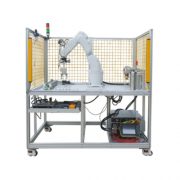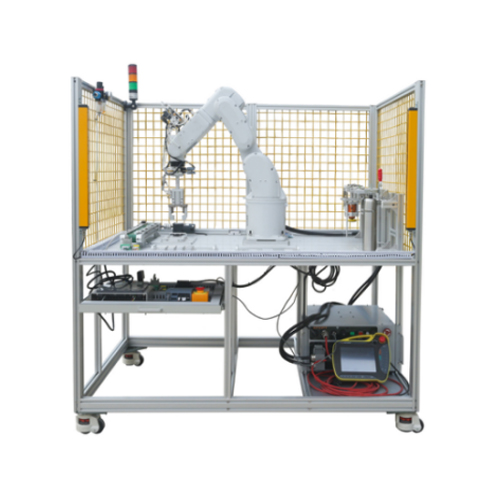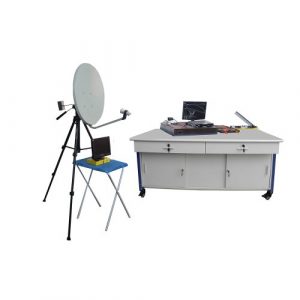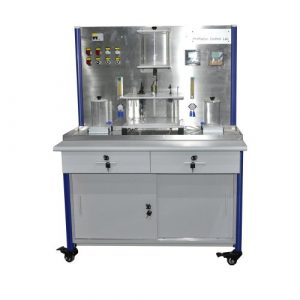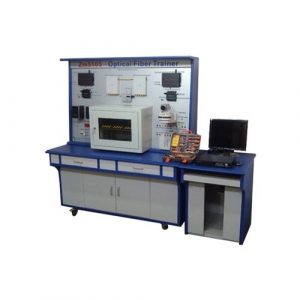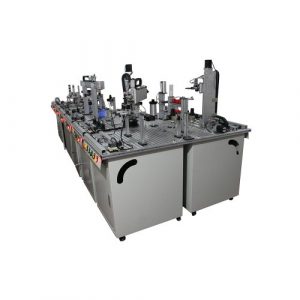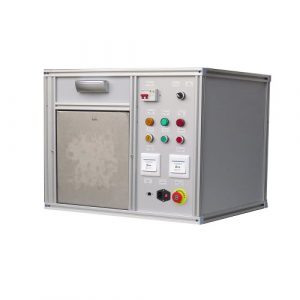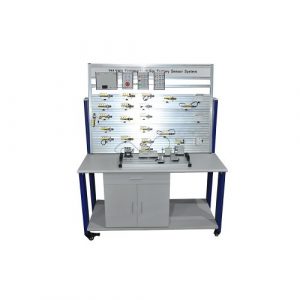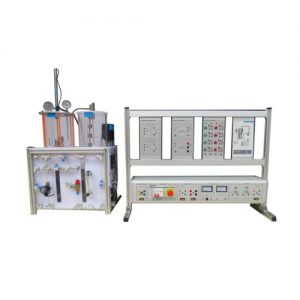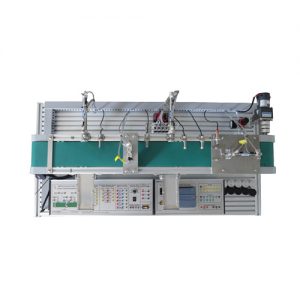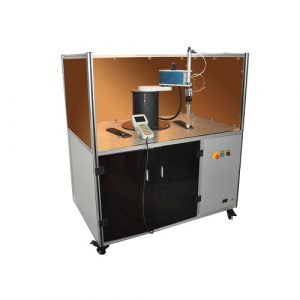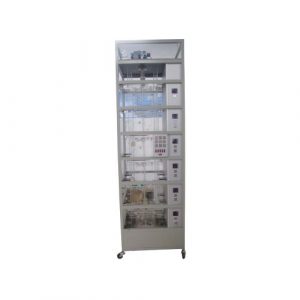- Description
- Inquiry
TB220505S35 Didactic Robot Station Trainer Teaching Equipment Automatic Training Equipment
1. System overview
The parallel robot teaching and training device integrates automatic control, position control, motor control, pneumatic control, programmable controller, sensor and other technologies, and is a typical mechatronic control device. The device helps students to learn about mechanical design, electrical automation, automatic control, computer technology, sensor and detection technology, industrial engineering and other knowledge. The application of programmable controller programming, sensor and detection technology, motor drive and control technology can improve students’ comprehensive abilities in design, assembly, and debugging.
The device consists of industrial parallel robot, controller and robot teaching box, parallel robot sorting unit, industrial vision system, industrial robot gripper, safety unit, electrical control system, pneumatic system, robot workbench, etc.
2. Basic technical parameters of the system
Robot brand: EFORT
Power of the whole machine: ≤2Kw;
Air source requirements: 0.4-0.6MPa (pressure), 30L/MIN (flow)
Safety protection measures: with overload, short circuit, leakage and other functions
Robot load capacity: 6kg
Number of axes: 6 axes
Safety protection: closed metal mesh and transparent door, safety light curtain protection
Equipment weight: 180Kg
3. Features of the system
The parallel robot teaching and training device comprehensively applies multi-disciplinary technology, which is suitable for the practical teaching of mechanical principles, automatic control principles, electrical control and programmable controllers, sensors and detection technology, computer control technology and other courses. In addition, the comprehensive training device has the following characteristics:
(1) The training device is a modular open design structure, which can not only be used as an independent system alone, but also can be combined with other similar equipment as a subsystem. Modules can be replaced to facilitate secondary development.
(2) The working process and operating status of various pneumatic components, electrical components and mechanical motion actuators are intuitive;
(3) The training device has manual and automatic control modes. Through manual control, the working performance of the main components such as the mechanical transmission mechanism, motor, limit protection switch, solenoid valve, air cylinder, air gripper, etc. of the device can be tested normally;
(4) The training table is composed of aluminum profiles and steel plates welded. The unique T-slot on the table is convenient for the disassembly and installation of mechanical parts and electrical components. The electrical installation board of the training table can be pulled out to facilitate circuit layout and installation and debugging. , In addition, the legs of the training table are equipped with rollers with brakes, which is convenient for the device to move the position;
(6) It has good safety performance.
4. Applicable professional courses
The parallel robot teaching and training device is suitable for the practical teaching of mechanical principles, automatic control principles, electrical control and programmable controllers, sensors and detection technology, computer control technology, industrial engineering and other courses.
5.Specific characteristics:
- Power supply: 120 Volt.
- Application: High speed handling.
- Load capacity: 0.5 Kilograms.
- Axes: 6.
- Includes: Controller, software, touch screen for controller, training car, air compressor.
- Type of structure: Articulated robot arm. Additional features:
- Six-axis mechanical robot, delta-shaped mechanical structure, for assembly and selection of parts (minimum range of 1250 mm).
Maximum load capacity 6Kg.
- Controlling Card.
- Software for programming and managing the robot.
- Available 4D graphics.
- Collision guard package.
- The robot complies with the following characteristics (Type: Link by parallel mechanism; Controlled Axes: 6 axes (J1, J2, J3, J4, J5, J6); Installation: It can be mounted on the floor, at an angle or from the sky ; Repeatability: +/-0.02 mm, complies with ISO 9283; Driving method: Electric servo mechanism)
- Memory: 64MB DRAM, and 2MB SRAM.
- 6 axis control based on PCB.
- 2 1OBaseT Ethernet ports.
- 1 iRVision analog camera port.
- 2 mini slots (compatible with DeViceNet, Profibus, CC-Link, Line Tracking, Aux-Axis, FL-Net breakout boards).
- 1 USB 2.0 port (accessible from the controller door).
- 1 RS-232-C / digital vision port.
- 1 force sensor / LVC port.
- 2 peripheral I/O ports (provides up to 28 digital inputs and 24 digital outputs).
- 1 I/O Link master/slave port or 1 High Speed Input (HDI) port (provides up to 2 HDI inputs) or 1 x I/0 Link i port (provides connection to secure I/O board DCS).
- Controller power supply.
- 6 channel servo amplifier.
- Rotary switch 10A & 200-230 VAC, single phase input voltage.
- Integrated operator panel (includes Auto / T1 mode switch, e-stop and cycle start buttons).
- A touch panel and USB 2.0 port.
- 10m cable for Pendant. Additional grippers packs (grippers) for 6-axis robot that includes:
- Standard Vacuum Cup: allows to simulate a pick and place application. The vacuum based air valve is robust and reliable.
- Mechanical clamp kit (includes clamps, accessories and connection hoses).
- Kit for the implementation of a project. that allows to emulate the classification of pills with basic 2D Vision and contrasting colors, which includes: clamp for pneumatic dual position, plastic bottles, plastic pills, loading tray / classification surface. 2D Vision System (with interface to the 6-axis mechanical arm robot), which allows:
- The vision process executed from the CPU of the main robot.
- View images and track production directly from the touch screen (Pendant).
- Capacity of vision algorithms for critical tasks and dynamically mask areas to ignore.
- Real-world lighting management with automatic exposure adjustment.
- Fully integrated robot command set.
- No PC or additional processing hardware required.
- Lighting kit for Vision system that provides a light source and a power connector. It must include the training of 3 instructors for the use and programming of the robots, with manufacturer certification. This training should be as follows:
- Robot programming and operation.
- Programming and operation of 2D Vision.
- Total, 88 hours of training as a minimum. The instructor and student manuals in Spanish must be delivered, as well as the instructor’s didactic guide and the student’s learning guide, in addition to the equipment installation and start-up manual.
6, can complete the experiment content:
- Basic understanding of parallel robots.
- Motion operation of the parallel robot teach pendant.
- Point teaching of parallel robots.
- Basic parameter setting of parallel robot.
- Basic motion instruction learning of parallel robots.
- Program editing of parallel robot based on teach pendant.
- Parallel robot IO control application.
- Basic wiring method of parallel robot.
- Simple trajectory running programming and teaching.
- Programming and teaching of plane and circular drawing tasks.
- Programming and teaching of plane rectangle drawing tasks.
- Programming and teaching of surface circle drawing tasks.
- Programming and teaching of surface rectangle drawing tasks.
- Fixed position handling programming and teaching.
- Plane position sorting programming and teaching.
- Application and control of industrial vision system.
- Industrial vision system and robot linkage control.
- Fixed position handling programming and teaching;
- Programming and teaching of visual inspection and classification arrangement;



